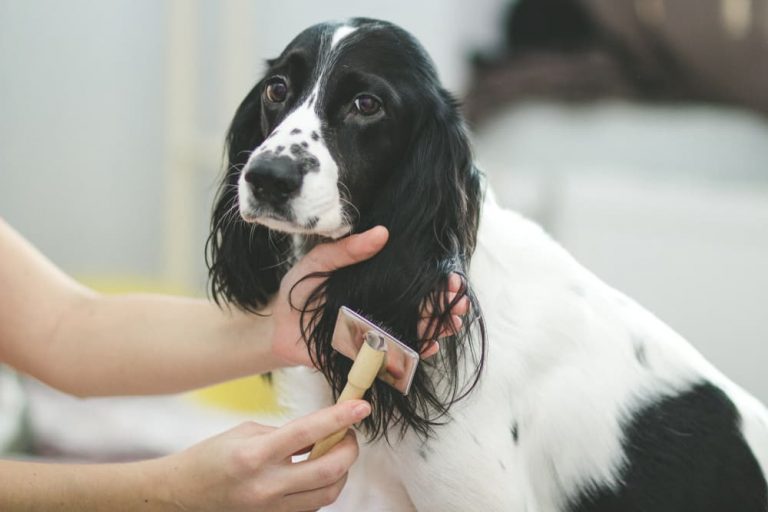Matted Dog Hair: Top Grooming Solutions

Most pet parents agree that matted dog hair looks unsightly, but it might not be common knowledge that mats can also cause pain, discomfort, and even major skin problems for our pets when they are not handled quickly and properly.
Luckily, a little knowledge goes a long way when it comes to preventing and handling this hairy issue. Here, Ani Corless, founder of the in-home dog grooming service Luxury Groomer, shares everything you need to know to keep your pet’s fur free of mats.
Matted Dog Hair: What Is It and How Does It Happen?

A mat is a tangle of fur that has gotten to the point that it needs proper brushing and combing out. “Most of the time, on a dog, a mat forms in the style of a webbing that goes all the way down to the skin,” says Corless. “It can look fine on top, but down at the skin the mat needs to be separated and combed out, or it will continue to get more and more tangled and knotted and can become tight to the skin.”
Unfortunately the beginning stages of matted dog hair can be very deceiving. “To the owner, the dog may look fine, but underneath the top coat, they might not be,” says Corless.
Some of the biggest factors that contribute to matting include:
The texture of your dog’s hair. Soft fur is more likely to get matted easily, as opposed to dogs with wiry or coarse coats.
Lifestyle choices. Anything that causes friction or rubs on your dog’s coat frequently—like clothing—can cause matting.
Water. Water not only helps create mats, but it may also tighten existing mats and make them worse. “Unless you’re a professional groomer brushing your dog out thoroughly before and after a bath and combing down to their skin, you could just be causing the issue with baths,” says Corless.
Why Is Matted Dog Hair a Problem?
Besides the aesthetic issue, a dog with matted hair may suffer from even more severe problems.
Essentially, “their skin isn’t breathing,” says Corless, “which can cause sores, or trap things like fleas and ticks. Plus, if you’re bathing a dog with mats, they might not get properly dried, so mold can grow.”
Many of these issues cause pain for dogs, as well. For example, some dogs that aren’t regularly groomed may have mats that grow to cover their eyes or rectal area, which can inhibit their ability to go to the bathroom properly and can lead to yeast infections. “In extreme situations, it can even cut off circulation on a limb, leading to amputation,” says Corless. “So, it’s not just aesthetic. If you let it get bad enough, it’s a health issue.”
How to Get Mats Out of Dog Hair

There are a few things you can try to do at home if your dog is suffering from mats, and some do’s and don’ts to keep in mind.
Learn Proper Brushing Techniques
When it comes to brushing, “you can have a groomer show you how to do it, or watch videos online on how to do it, as long as you watch videos specific to your breed.” A video that Corless created during the pandemic on proper dog grooming is a good place to start.
Get the Right Tools
Corless suggests doing some research to determine the best brush for your specific breed. “Most need a slicker brush, as well as a comb, because no matter what brush you get, it’s only going over the top layer and not getting into that netting,” she added.
Find the Right Spot
If you’re going to attempt to brush and comb a mat out of your dog’s hair, Corless suggests finding a spot, especially for smaller dogs, where you can put them up on something—like a counter or washing machine—to have better access and to keep them from running away and causing a battle. Just make sure they are secure.
Avoid Shaving and Cutting
Never shave or cut mats off your dog, as this can be very dangerous and may lead to you inadvertently cutting the skin. If you think either shaving or cutting is necessary, it is time to get a professional groomer involved so they can safely remove stubborn or large mats.
Be Selective With Home Remedies
Although some products—like spray detanglers, oils and even cornstarch—might help a little bit, if you’re not properly trained in how to remove them, then you’re essentially just adding more moisture to the mat, which could make it worse. “Most of the time I say leave that stuff up to the groomer, unless your dog is only slightly knotted and you’d like to try a bath with a good conditioner before brushing,” she says.
How to Prevent Mats in Dog Hair
Finding a maintenance haircut and grooming schedule that fits with your lifestyle is a good start to avoiding mats, and other than that, Corless suggests working with your groomer to have them demonstrate for you the proper brushing and combing techniques.
It’s also important to consider your dog’s (and your) lifestyle, and to determine if you’ll really be more likely to cut something out of their life that causes mats (like swimming), or if you can bring them into the groomer as often as they might need to be professionally treated.
If you realistically know that these things aren’t an option, then Corless suggests just keeping your dog’s hair as short as possible. “Length of hair contributes to mats developing, as well,” she says. “Any bit of length mats more quickly.”









